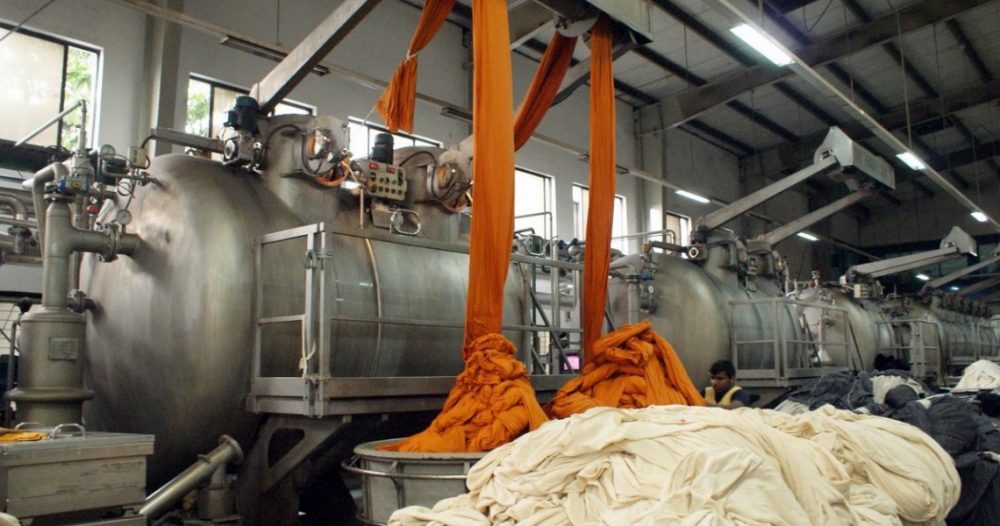Lisa Lockwood
Ralph Lauren Corp. on Monday introduced Color on Demand, a multiphased system that expects to deliver the world’s first scalable zero wastewater cotton dyeing system.
Each year, trillions of liters of water are used for fabric dyeing alone, generating around 20 percent of the world’s wastewater, according to a report from the Ellen MacArthur Foundation, Circular Fibres Initiative. This untreated wastewater is extremely polluting and traditionally required rigorous, lengthy and costly treatment to make the water reusable.
In order to help address water scarcity and pollution caused by cotton dyeing, Color on Demand is a system composed of a set of technologies that will enable the recycling and reuse of all water from the dyeing process. In addition to sizable water savings, Color on Demand significantly reduces the amount of chemicals, dye, time and energy used in the cotton dyeing process. Color on Demand also provides a more efficient and sustainable way to color cotton at any point in product manufacturing, rather than at the outset, which is a first for the industry. This will enable shorter lead times for making product color decisions.
The company’s goal with Color on Demand is to establish a new standard for the industry, and the company is encouraging industry peers to join in its efforts.
“Traditional color dyeing is one of the most polluting practices in our industry and as a global brand, we recognized the need to create a scalable solution,” said Halide Alagöz, chief product and sustainability officer at Ralph Lauren. “Color on Demand significantly reduces the environmental impact of dyeing cotton, and as an added benefit, will enable us to better balance inventory and meet personalized consumer demands faster than ever before.”
To implement this, Lauren brought together four leading innovators in their respective fields, including Dow in materials science; Jeanologia, in sustainable solutions for garment and fabric finishing, with expertise in dyeing and close loop water treatment systems; Huntsman Textile Effects, which specializes in textile dyes and chemicals, and Corob, a technology leader in dispensing and mixing solutions to reimagine each state of the coloring process.
In the first phase of Color on Demand, Lauren optimized the use of EcoFast Pure Sustainable Textile Treatment, a pre-treatment solution developed by Dow for cotton textiles. When used with existing dyeing equipment, EcoFast Pure enables the use of up to 40 percent less water, 85 percent fewer chemicals, 90 percent less energy and a 60 percent reduction in carbon footprint compared to traditional cotton dyeing processes. Lauren is integrating this process into its supply chain and will launch product using this technology later this year.
Last June, WWD reported that Lauren joined forces with the World Wildlife Foundation to drive progress toward the company’s goal of reducing water use across its operations and value chain by 20 percent by 2025.
“Water scarcity and pollution are important issues for the fashion industry, and through our partnership with Ralph Lauren we are working toward addressing these challenges,” said Sheila Bonini, senior vice president, private sector engagement at World Wildlife Fund. “Technology has the ability to accelerate change at a scale that matters, so it’s exciting to see Ralph Lauren establishing innovative new models that transform outdated practices and can deliver measurable outcomes for people and planet. This is exactly the kind of leadership we need to see from the fashion industry.”
As reported, Lauren has said it is working to eliminate hazardous chemical use in its supply chain and reduce water use across its operations and value chain by 2025. By that year, Ralph Lauren aims to use the Color on Demand platform in more than 80 percent of the company’s solid cotton products.
Lauren’s strategy, called Design the Change, is anchored in commitments to drive progress across three focus areas: Creating Timeless Style, Protecting the Environment and Championing Better Lives, as reported. The company is a signatory to the We Are Still In declaration and the U.N Fashion Industry Charter for Climate Action, pledging to limit its emissions in line with the Paris Agreement goals. The company is also a member of the G7 Fashion Pact, a group of fashion leaders working to stop global warming, restore biodiversity and protect the oceans.
Πηγή: finance.yahoo.com

